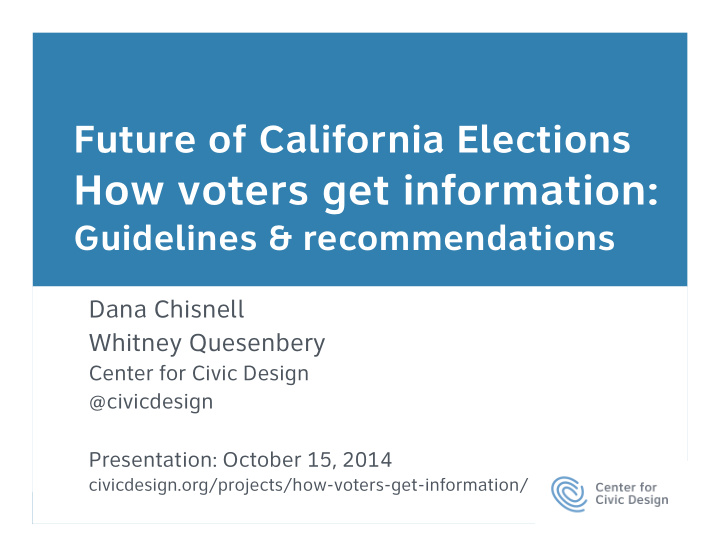



Future of California Elections How voters get information: Guidelines & recommendations Dana Chisnell Whitney Quesenbery Center for Civic Design @civicdesign Presentation: October 15, 2014 civicdesign.org/projects/how-voters-get-information/
About the project § 1 year § 38+ partners § 58 counties § 100 research participants § Voters, non voters, infrequent voters § Young, new citizens, low literacy, people with disabilities, language minorities § And many miles
It took many amazing people Election officials: Cathy Darling Allen (Shasta County), Jill Fox & Barbara Carr (San Francisco), Neal Kelley (Orange County), Dean Logan (Los Angeles County), Gail Pellerin (Santa Cruz County), Kari Verjil, Rebecca Spencer & Art Tinoco (Riverside County), Michael Vu (San Diego County), Debbie O’Donoghue & Nicole Winger (California Secretary of State’s office), Mac Taylor, Brian Brown & Jason Sisney (California Legislative Affairs Office) FOCE Members and other advocacy groups: Tanzila Ahmed, Deanna Kitamura, Eugene Lee, and Nathanel Lowe (Asian Americans Advancing Justice – Los Angeles), Kim Alexander (California Voter Foundation), Caroline Bruister (California Forward), Kathay Feng (California Common Cause), Almas Haider (South Asian Network), Rosalind Gold and Ofelia Medina (National Association of Latino Elected and Appointed Officials Education Fund), Eileen Ma (API Equality - LA), Fred Nisen and Bill Hershon (Disability Rights California), Michelle Romero (The Greenlining Institute), Bo Sivanunsakul (Thai Community Development Center), Sabrina Smith (California Calls), Susan Stuart Clark (Common Knowledge), Ernie Ting (Smart Voter), Raquel Beltran (League of Women Voters of Los Angeles), Thea Brodkin (League of Women Voters of Santa Monica), Kathy Souza & Mony Flores-Bauer (League of Women Voters of California, Voter Service Directors) Research hosts and recruiting assistance: Berkeley Reads / Linda Sakamoto-Jahnke, Billy DeFrank Lesbian and Gay Community Center, California Community Foundation, CAUSE / Carrie Gan, Ed Roberts Campus/ Fred Nisen and Dmitri Belser, Los Angeles County Clerk’s office / Dean Logan, Efrain Escobedo and Monica Flores, Modesto Parks & Recreation Staff, NALEO / Ofelia Media, Alberto Avalos, St. John the Baptist Church
Three big insights § Plain language can't be overemphasized § Civic literacy is a huge challenge § Layout and visual presentation are important for comprehension
Two big sections of the guide Large, ¡clear ¡groupings ¡in ¡the ¡ headings ¡and ¡table ¡of ¡contents ¡ helped ¡voters ¡understand ¡ what ¡is ¡in ¡the ¡voter ¡guide. ¡
Recommendations § the right information § organized in the right way § presented so it is easy to read and understand § and personalized for them § helping address the civic literacy gap
Plain language Let us tell you about Bill...
Read ¡it ¡online: ¡h:p://civicdesign.org/projects/how-‑voters-‑get-‑informa?on/ ¡
Civic literacy Elections are not intuitive
How many ways can you vote? § vote by mail § early voting § vote at the polls
Identify options clearly
Help people ask the right questions and find the answers Question Question # Asking # Asking Variations of the question ariations of the question What’s on the ballot? 39 • What’s on the ballot? • Who do I support or vote for? • Who is running? • Who will I be voting for? • Who are the candidates? • Who supports the candidates? • What are the candidates’ positions on [specific issue]? • What are the ballot measures? • What are the pros and cons for the measures? • Does this measure mean a tax increase? • How does the official guide compare to the TV ads? • Who is in office right now?
Help people answer their questions An?cipate ¡and ¡answer ¡voters' ¡ ques?ons, ¡rather ¡than ¡just ¡ telling ¡them ¡what ¡we ¡think ¡ they ¡need ¡to ¡know. ¡
Layout and design Making information easy to recognize
Layouts signal meaning
Layouts help reinforce meaning
Design supports navigation
Recommendations
Recommendations § Include the right information at the appropriate level of detail § Organize information for progressive disclosure § Present information so it is easy to read and understand § Personalize information for the voter § Close civic literacy gaps through structure and content
Write headings as questions or active instructions Heading st Heading styl yle e Ex Exampl ample e Why it works Why it works What is the last day to Suggests a question Question request a vote-by-mail that voters ask ballot? How to request a vote-by- Suggests the answer Quasi-question mail ballot. the section contains Request a vote-by-mail Provides the answer, Instruction ballot by October 29. making the question implicit
Use visuals to reinforce information about elections Showing ¡both ¡voter ¡guide ¡ covers ¡helps ¡voters ¡ understand ¡that ¡there ¡are ¡two ¡ booklets, ¡and ¡recognize ¡them ¡ when ¡they ¡arrive. ¡ ¡
Bite-snack-meal The ¡official ¡term ¡is ¡"progressive ¡disclosure" ¡
Making it happen Next steps
Change happens step by step § The ideas come from the current voter guides... and voters § A deepening of the Field Guides § Don't be afraid to rethink § Work the 'adjacent possible' § But, some recommendations require legislation
Report, prototype, and other materials civicdesign.org/projects/how-voters-get-information/ Dana Chisnell dana@civicdesign.org Whitney Quesenbery whitneyq@civicdesign.org civicdesign.org @civicdesign
Thank you.
Recommend
More recommend